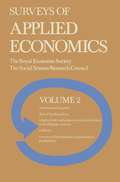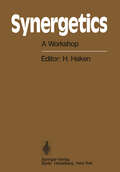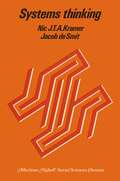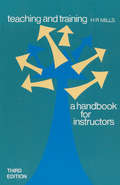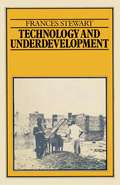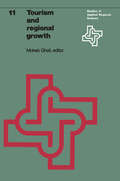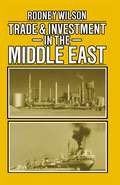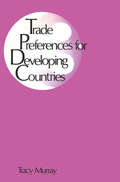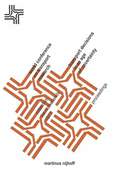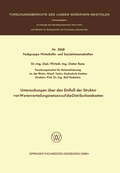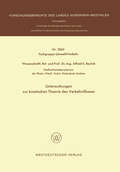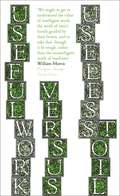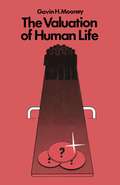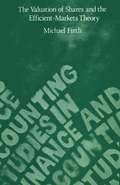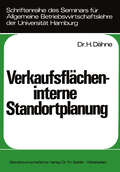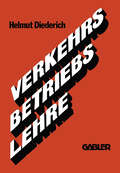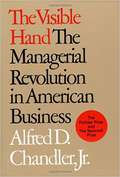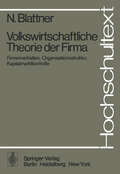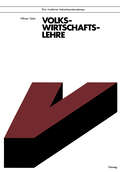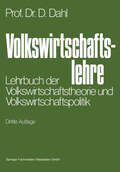- Table View
- List View
Synergetics: A Workshop Proceedings of the International Workshop on Synergetics at Schloss Elmau, Bavaria, May 2–7, 1977 (Springer Series in Synergetics #2)
by Hermann HakenThis volume contains most of the invited papers presented at the International Work shop on Synergetics, Schloss E1mau, Bavaria, May 2 to.May 7, 1977. This workshop fol lowed an International Symposium on SynergetiGS at Schloss E1mau, 1972, and an Inter national SUl11l1erschoo1 at Erice, Sicily, 1974. Synergetics is a rather new field of interdisciplinary research which studies the self-organized behavior of systems leading to the formation of structures and func tionings. Indeed the whole universe seems to be organized, with pronounced structures starting from spiral galaxies down to living cells. Furthermore, very many of the most interesting phenomena occur in systems which are far from thermal equilibrium. Synergetics in its present form focusses its attention on those phenomena where dra matic changes occur on a macroscopic scale. Here indeed Synergetics was able to re veal profound analogies between systems in different disciplines ranging from physics to sociology. This volume contains contributions from various fields but the reader will easily discover their cOl11J1on goal. Not only in the natural sciences but also in ecology, sociology, and economy, man is confronted with the problems of complex sys tems. The principles and analogies unearthed by Synergetics will certainly be very he1pfu~ to cope with such difficult problems. I use this opportunity to thank the Vo1kswagenwerk Foundation for its support of the project Synergetics and in particular for sponsoring the International Workshop on Synergetics.
Systems thinking: Concepts and notions
by N.J.T.A. Kramer J. de SmitThere is no generally accepted, clearly delineated body of know ledge concerning systems thinking. The multiplicity of thinking is well illustrated by the various names such as: (general) systems theory, systems thinking, systems approach, systems analysis, sys tems synthesis, systems engineering, etc. These terms refer to various fields of knowledge that either overlap or are completely different. For this reason we consider it useful to try to develop a common language, a common set of concepts. In this book we have tried to launch such a common language. We shall try to develop a set of coherent concepts and notions. We have consciously tried to make the minimum use of mathematical or logical symbols in our descriptions and definitions. This promotes more positive access to the concepts. We think that the language of the formal sciences, mathematics, can only be pardy of use to us in considering the application of systems thinking in complex em pirical situations. Our set of concepts is based on various descrip tions known from the literature. In order to explain the concepts and ideas as clearly as possible, we have illustrated them with exam ples from various academic fields such as sociology, psychology, business, management, economics, technology and the natural sciences. In the main, we have chosen relatively simple examples.
Tourism and regional growth: An empirical study of the alternative growth paths for Hawaii (Studies in Applied Regional Science #11)
by M. A. GhaliThe purpose of this study is to analyze the alternative growth paths open to a region under various policies designed to control the growth oftour ism. This is motivated by the current interest of decision-makers in con trolling the growth of tourism. Such interest and any policies which emanate from it may prove detrimental unless a thorough understanding of the consequences of these policies are the foundation upon which the decisions are made. The study consists of four parts, each is written by an author or a group of authors. Thus, while the logical sequence of the parts and the feedbacks among them unify the study, the methodology adopted in each is different, reflecting the diversity and dexterity of forecasting techniques in econo mics. This variety of techniques is desirable in itself as it exposes the reader to some of the alternative approaches. In chapter 1, the theory of regional growth, and in particular the dis tinction between the supply-based and the demand-based models, is dis cussed. The role played by natural resource constraints is shown to be absent from both types of models, and it is argued that this role can be investigated by considering the alternative growth paths available to the region through variations in the rate oftuilization of the resource. To ac complish that, however, a model of regional growth is needed. The empiri cal evidence provided favour a demand-type model. A model of this type is developed and utilized in succeeding parts of the study.
Transport decisions in an age of uncertainty: Proceedings of the third World Conference on Transport Research Rotterdam, 26 – 28 April, 1977
by E. J. VisserProceedings of the 3rd World Conference on Transport Research, Rotterdam, The Netherlands, April 1977
Unternehmungsführung und Unternehmungsziele: Eine Untersuchung des Wissenschaftsprogrammes der betriebswirtschaftlichen Theorie der Unternehmungsführung und des Zusammenhanges von Ziel-Funktions-Hierarchien und Führung
by Werner HesshausUntersuchungen über den Einfluß der Struktur von Warenverteilungsnetzen auf die Distributionskosten (Forschungsberichte des Landes Nordrhein-Westfalen #2668)
by Dieter KunzUntersuchungen zur kinetischen Theorie des Verkehrsflusses (Forschungsberichte des Landes Nordrhein-Westfalen #2662)
by Alfred E. BeylichUseful Work v. Useless Toil (Penguin Great Ideas Ser. #Vol. 3)
by William MorrisVisionary English Socialist and pioneer of the Arts and Crafts movement, William Morris argued that all work should be a source of pride and satisfaction, and that everyone should be entitled to beautiful surroundings – no matter what their class. Throughout history, some books have changed the world. They have transformed the way we see ourselves – and each other. They have inspired debate, dissent, war and revolution. They have enlightened, outraged, provoked and comforted. They have enriched lives – and destroyed them. Now Penguin brings you the works of the great thinkers, pioneers, radicals and visionaries whose ideas shook civilization and helped make us who we are.
Valuation of Shares and the Efficient-markets Theory (Studies in Finance and Accounting)
by Michael FirthVerkaufsflächeninterne Standortplanung (Schriftenreihe des Seminars für Allgemeine Betriebswirtschaftslehre der Universität Hamburg #9)
by Helmut DähneThe Visible Hand: The Managerial Revolution in American Business
by Alfred D. Chandler Jr.The role of large-scale business enterprise—big business and its managers—during the formative years of modern capitalism (from the 1850s until the 1920s) is delineated in this pathmarking book. Alfred Chandler, Jr., the distinguished business historian, sets forth the reasons for the dominance of big business in American transportation, communications, and the central sectors of production and distribution.
The Visible Hand: The Managerial Revolution in American Business
by Alfred D. Chandler Jr.The role of large-scale business enterprise—big business and its managers—during the formative years of modern capitalism (from the 1850s until the 1920s) is delineated in this pathmarking book. Alfred Chandler, Jr., the distinguished business historian, sets forth the reasons for the dominance of big business in American transportation, communications, and the central sectors of production and distribution.
Volkswirtschaftliche Theorie der Firma: Firmenverhalten, Organisationsstruktur, Kapitalmarktkontrolle (Hochschultext)
by N. BlattnerVolkswirtschaftslehre: Lehrbuch der Volkswirtschaftstheorie und Volkswirtschaftspolitik
by Dieter DahlDas vorliegende Lehrbuch ist vor allem für Studenten der Wirtschaftsakademien und Fachhochschulen gedacht; aber auch dem Universitätsstudenten, der eine praxisnahe Einführung sucht, mag es nützlich sein. Das auf Wirklichkeitsnähe ausgerichtete Studium verlangt nach einer besonderen Darstellung: Einerseits sollen moderne Problemstellungen der Theorie, wie volkswirtschaftliche Gesamt rechnung, einschließlich der Input-Output-Analyse, oder die Verteilungstheorie, angesprochen sein, andererseits wird besonderer Wert gelegt auf die Verbindung von Volkswirtschaftstheorie und Volkswirtschaftspolitik. Damit sich der Leser an gesamtökonomische Größenordnungen gewöhnt, spre chen wir beispielsweise nicht nur von Vollbeschäftigung, sondern nennen die Zahlen der Erwerbstätigen und Arbeitslosen in der Bundesrepublik oder stellen neben die verschiedenen Sozialproduktsbegriffe die gegenwärtigen Zahlen. Wir diskutieren nicht nur den Geldmengenbegriff und die Umlaufgeschwindigkeit des Geldes, wir weisen auf die Zahlen und auf die Quellen hin, so daß der Leser z. B. aus den Monatsberichten der Bundesbank spätere Veränderungen feststellen kann. Auch die jüngsten Jahresgutachten mit ihren Empfehlungen für die Wirt schaftspolitik, ihre Hinweise auf das zweckmäßige Verhalten der Träger der Wirtschaftspolitik, seien es Staat, Gewerkschaften oder Unternehmerverbände, werden in die systematische Darstellung einbezogen. Des Denkimpulses wegen bringen wir manches Problem in Frageform, so daß der Leser sich selbst Gedanken machen kann, bevor er die Lösung liest. Zur Repeti tion ist außerdem jeweils am Ende der acht Buchteile eine Reihe von Fragen angeschlossen, die aus der vorangegangenen Darbietung heraus ohne weiteres gelöst werden können. In einprägsamer Kurzform sind jedem Buchteil die darin neu verwendeten Begriffe in alphabetischer Ordnung vorangestellt, sie sind außerdem über das Register am Schluß des Buches auffindbar.
